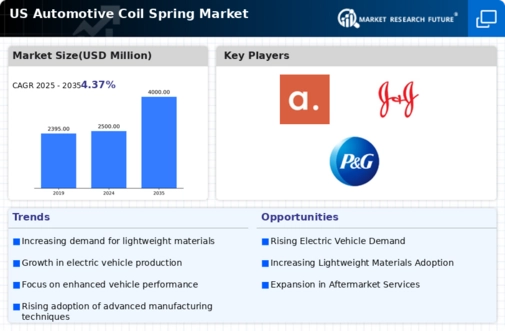Growth of the Automotive Aftermarket
The automotive aftermarket sector significantly influences the automotive coil-spring market. As vehicle ownership rates rise, the demand for replacement parts, including coil-springs, is expected to increase. In 2025, the aftermarket for automotive components is projected to reach $300 billion in the US, with coil-springs representing a substantial segment. This growth is driven by factors such as aging vehicle fleets and the need for regular maintenance. The automotive coil-spring market must capitalize on this trend by ensuring a steady supply of high-quality replacement springs to meet the needs of both consumers and repair shops.
Rising Demand for Vehicle Performance
The automotive coil-spring market experiences a notable boost due to the increasing consumer demand for enhanced vehicle performance. As consumers prioritize driving experience, manufacturers are compelled to innovate and improve suspension systems. This trend is particularly evident in the growing popularity of performance-oriented vehicles, which often require advanced coil-spring designs to optimize handling and ride comfort. In 2025, the automotive coil-spring market is projected to witness a growth rate of approximately 6% annually, driven by this performance-centric consumer behavior. The automotive coil-spring market must adapt to these evolving preferences, ensuring that products meet the rigorous standards set by performance enthusiasts.
Regulatory Standards and Safety Requirements
Regulatory standards and safety requirements significantly impact the automotive coil-spring market. As safety regulations become more stringent, manufacturers are compelled to enhance the quality and performance of coil-springs. Compliance with these regulations not only ensures consumer safety but also influences the design and materials used in production. In 2025, the automotive coil-spring market is likely to see increased investments in research and development to meet these evolving standards. This focus on safety may lead to innovations that improve the overall performance and reliability of suspension systems, thereby benefiting both manufacturers and consumers.
Sustainability and Environmental Considerations
Sustainability is emerging as a pivotal driver in the automotive coil-spring market. With growing awareness of environmental issues, manufacturers are increasingly adopting eco-friendly practices in production. This includes utilizing recyclable materials and reducing waste during the manufacturing process. The automotive coil-spring market is likely to see a shift towards sustainable practices, as consumers become more conscious of their environmental impact. In 2025, it is anticipated that the demand for sustainably produced coil-springs will rise, potentially influencing purchasing decisions. This trend not only aligns with The automotive coil-spring market.
Technological Advancements in Suspension Systems
Technological advancements play a crucial role in shaping the automotive coil-spring market. Innovations in materials and design methodologies have led to the development of more efficient and durable coil-springs. For instance, the introduction of computer-aided design (CAD) and simulation tools allows manufacturers to optimize spring geometry for better performance. Additionally, the integration of smart technologies, such as adjustable coil-springs, is gaining traction. These advancements not only enhance vehicle dynamics but also contribute to the overall safety and comfort of the ride. The automotive coil-spring market is likely to benefit from these technological improvements, as they align with the increasing consumer expectations for high-performance vehicles.














Leave a Comment